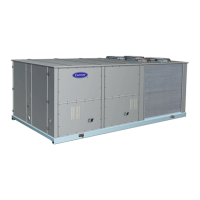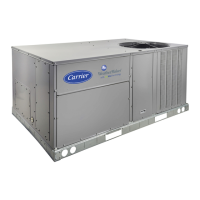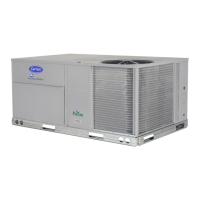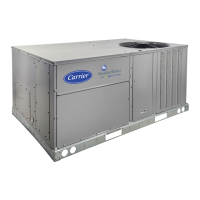32
APPLICATION DATA (cont.)
Sizing a rooftop
Bigger isn’t necessarily better. While a n air conditi oner
needs to have enough capacity to meet the design loads, it
doesn’t need excess capacity. In fact, excess capacity
typically results in very poor part load performance and
humidity control.
Using higher design te mperatures than ASHRAE
recom mends for your location, adding “safety factors” to
the calculated load, are all signs of oversizing air
conditioners. Oversizing the a ir conditioner leads to poor
humidity control, reduced efficiency, higher utility bills,
larger indoor temperature swings, excessive noise, and
increased wear and tear on the air conditioner.
Rathe r than oversizing an air conditioner, engineers
should “right size” or even slight ly undersize air
conditioners. Correctly sizing an air conditioner cont rols
humidity better; promotes efficiency; reduces utility bills;
extends equipment life, and maintains even, c omfortable
temperatures. Please contact your local Carrier
representative for assistance.
Low ambient applications
The opt ional Ca rrier economizer can adequately cool your
space by bringi ng in fresh, cool outside air. In fact, when
so equipped, accessory low ambient kit may not be
nece ssary. In low ambie nt conditions, unless the outdoor
air is excessively humid or contaminated, economizer
based “free cooling” is the pre ferred less costly and
energy conscious method.
In low ambient applications where outside air might not
be desired (such as contaminated or excessively humid
outdoor environments), your Ca rrier rooftop can operate
at ambient temperatures down to --20_F(--29_C) using the
recommended accessory Motormaster low ambient
controller.
Staged Air Volume (SAV) with Variable
Frequency Drive (VFD)
Carrier’s Staged Air Volume (SAV) system utilizes a
Va riable Frequency Drive (VFD) to automatically adjust
the indoor fan motor speed in sequence with the units
cooling operation. Per ASHRAE 90.1 2010 standard
section 6.4.3.10.b, during the first stage of cooling
operation the VFD will adjust the fan motor to provide
2/3rd of the total cfm established for the unit. When a call
for the second stage of c ooling is required, t he VFD will
allow the total cfm for the unit established (100%).
During the he ating mode, the VFD will all ow t otal design
cfm (100%) operation and during the ventilation m ode the
VFD will allow operation to 2/3rd of total cfm.
The VFD used in Carrier’s SAV system has soft start
capabilities to slowly ramp up the speeds, thus eliminating
any high inrush air volume during initial start--up. It also
has internal over current protection for the fan motor and
a field installed display kit that allows adjustment and in
depth diagnostics of the VFD.
This SAV system is available on models with 2--stage
cooling operation with electrical mechanical or RTU Open
(multi Protocol) controls. Both space sensor and
convent ional thermostats/controls can be used to provide
accurate control in any application.
The SAV system is very flexible for initial fan
performance set up and adjustment. The standard fac tory
shipped VFD is pre programmed to automatically stage
the fan speed between the first and second stage of
cooling. The unit fan performance static pressure and cfm
can be easily adjusted using the traditional means of
pulley adjustments. The other means to adjust the unit
static and cfm performance is to utilize the field installed
display module and adjust the frequency and voltage in
the VFD to required performance requirements. In either
case, once set up the VFD will automatically adjust the
speed bet we en the cooling stage operation.

